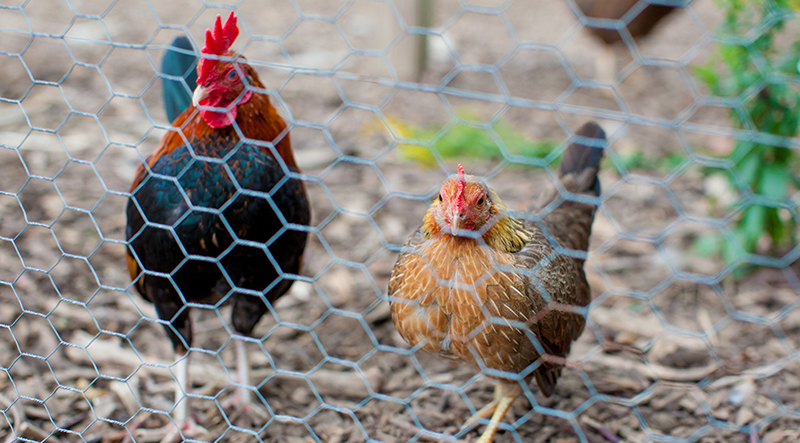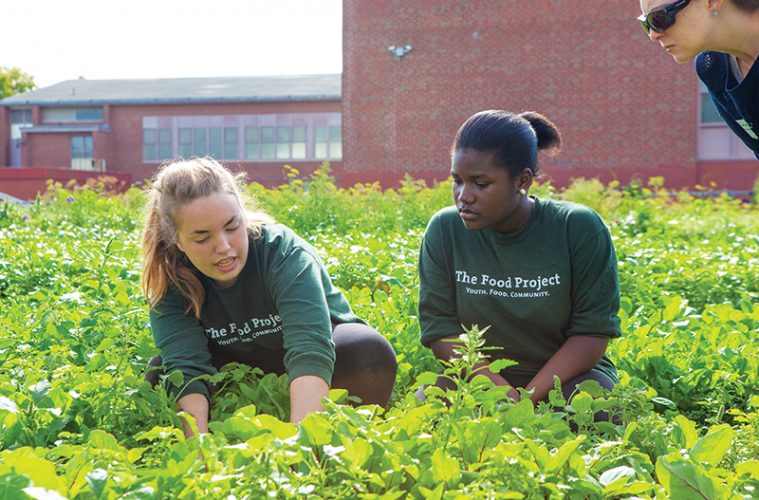It’s a fine fall morning when The Food Project’s acting executive director, James Harrison, sits down to explain the fairly complex youth programming that unfolds throughout the year on two acres belonging to The Trustees of Reservations at Long Hill in Beverly.
Started in 1991 in Lincoln and Weston, The Food Project has since expanded into Boston and its surrounding neighborhoods. In 2005, a North Shore branch was launched on a site in Lynn where 25 youth farmed half an acre at the Ingalls School, and also helped out at Appleton Farms in Ipswich. Today, 30 core staff members work with over 150 teens and thousands of volunteers on 31 acres in Lincoln, seven acres in Beverly, two and a half acres in Boston, one acre in Lynn, and soon a new 31-acre Wenham site, which should be fully operational within two years.
Youth come from 39 cities to participate in The Food Project. The program runs out of three offices and comprises 12 farms and greenhouses. Young people from both urban and suburban neighborhoods work in rural Beverly and in the city of Lynn, and are thereby exposed to diverse communities. The North Shore chapter is responsible for the building of 911 backyard and community raised-bed gardens in Boston, Lynn, and Gloucester, and services five farmers’ markets. Youth grow 250,000 pounds of organic produce each year—donating it to hunger relief organizations and selling it at farmers’ markets and through community supported agriculture (CSA) farm shares.
The program’s founder, Ward Cheney, believed “by growing food and working with others, we act on our desire to learn, to serve, and to be productive.” Drawing on his experience as a farmer, organizer, educator, and activist, he envisioned The Food Project as a national model for transforming urban and suburban young people and their communities. Today, it is exactly that.
As an educator with a background in agriculture, Harrison has much in common with Cheney and is uniquely qualified for his position. He brings to the work an understanding of sustainable farming techniques as well as an empathetic nature that lends itself well to effective communication—a key component of the program. Creating a “safe” environment in which youth can express themselves, explore social issues, and get to know one another is part and parcel to The Food Project’s mission. A unique aspect of the program is that young people who would normally never meet come together and truly bond as a result of their time in the field, in workshops, and in the community at large. “The key to the program’s success,” says Harrison, “is having as diverse a group as possible.”
 |
“Youth-driven food enterprises” expose participants to a series of complex ideas that start unfolding as soon as they enter the program as Seed Crew members—a paid position for which they must formally apply. While part of the summer Seed Crew, youth work in the fields for eight hours each weekday, learning through hands-on experience how to plant, weed, and harvest fruit, vegetable, and herb crops. They spend afternoons participating in a series of workshops covering issues related to personal development, sustainable agriculture, nutrition, food security, the food system, diversity, and social justice. Each Wednesday, they prepare and serve the food they’ve harvested to clients at a local hunger relief organization, and at least once during the summer, they staff one of the “affordable farmers’ markets,” which serve low-income communities.
That hands-on experience allows them the time and space to grapple with the concepts they have been introduced to in the workshops. “There’s something about working in the field,” muses Harrison, “that lends itself to great discussions. You have time to think.” Planting, tending, and harvesting crops also provides a connection to land and introduces youth to the health benefits of eating fresh food. “It helps them understand that what they eat has an effect on the environment,” notes Harrison.
Ultimately, graduates from the Seed Crew go on to join the D.I.R.T. Crew—dynamic, intelligent, responsible teenagers—at which time they step up to take on a serious leadership role. Up until that point, they have been under the guidance of crew and assistant leaders. Now, they themselves lead groups of farm volunteers, help recruit new candidates for the Seed Crew, and undertake a major community project of their own design. “They [also] provide support to food access activities by running farmers’ markets, building raised-bed gardens for low- income families, and working at hunger relief organizations,” explains Harrison.
The last leg of The Food Project journey takes places during the academic year for 42 weeks. The Root Crew is composed of 16 of the 60 young people who participated in the summer program. They are expected to put in two hours during the school week and time on Saturdays. They oversee “Serve and Grow Saturdays,” leading volunteers through “a day on the farm.” They also facilitate leadership and communication development workshops, during which they practice their newly acquired public speaking and community outreach skills. “The Root Crew gives graduates of our previous programs the chance to become the drivers of change,” notes Harrison. “Through this hands-on process, these young people become advocates for a just and sustainable food system.”
During the winter months, they close the farms and transition into service work, which, Harrison says, “is an opportunity to deepen their understanding of service.” They may, for instance, serve food in a homeless shelter, where they not only help with the labor but also gain an understanding of the issues surrounding homelessness. Additionally, they learn why some people have ready access to fresh, local food while others don’t. “At the root of the program,” explains Harrison, “is the hope that, empowered with knowledge and the skills to share it with others, graduates will work to raise awareness of these issues among a diverse range of audiences.”
Beyond providing educational employment for young people and food for hunger relief organizations, The Food Project serves as a nationwide model for other youth development programs. “Even projects completely unrelated to farming can draw on our methods for building inspired, diverse, and productive youth communities,” says Harrison. “People from across the country visit us to learn about our work, and [then] return to their communities inspired to accelerate the movement for real food.”
The program’s incredible value is given voice by Julia Fibb. A senior at Hamilton-Wenham High School, Fibb was introduced to The Food Project her freshman year. “I always loved gardening and doing things outside,” she recalls. “We’ve always had a vegetable garden.” Fibb’s mother encouraged her to apply, suggesting it would be an excellent opportunity. “I approached it as a job, not knowing what was going to come of it,” says Fibb. “It has turned into this huge passion that I have.”
The very articulate Fibb explains that she entered the program a painfully shy, quiet girl who was petrified to speak in front of others. “Now, I do a lot of facilitating with different organizations, groups, and youth in the program,” she says. “I grew tremendously as a facilitator.”
Fibb is heading to college soon, where she plans to study agriculture and social justice. “I come from a suburban, very white community and had never really been exposed to all the different levels of the economic scale—that is another part of The Food Project that has had a very big impact on my life.” She makes the point that in a typical teenager’s day, there are few opportunities to learn about things like social justice, the value of diversity, and issues of oppression.
“Because of The Food Project,” notes Fibb, “I’ve gained perspective on diversity as a whole and the impact it can have on different people…. I think I have been given an awesome opportunity. Most people from the town that I live in really have no exposure to [diversity]. It’s been eye-opening.”
Fibb shares her fondest memory of The Food Project to date, describing a scene at Open Door, a homeless shelter in Gloucester. She and another youth were rolling out pizza dough. “We were in the kitchen, prepping for a meal that we were going to eat together as a crew, and there was just this shift from being friendly, but not that close,to having the experience of cooking the food that we had grown on the farm together for a meal that we would all share.” Today, on her bedroom wall, there hangs a photo of that memory—two girls covered in flour, laughing. “It was one of those moments that just changed my relationship with my [now-good] friend and with The Food Project,” says Fibb. “Relationships can be built around food.” thefoodproject.org
YOUTH IN ACTION
To get a real feel for The Food Project, spend a few minutes watching one of their online videos. In “A Convenient Injustice,” young people share their thoughts on whether or not access to healthy food is a human right. All agree: It is. They consider affordability and explore the repercussions of poorer quality foods. After looking at many sides of the issue, they recommend action items “for how to make a difference going forward.”

